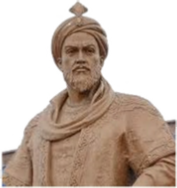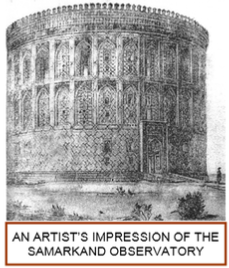


ULUGH BEG 1394 -
xxxxxThe astronomer and mathematician Ulugh Beg was the grandson of the Mongol leader Tamerlane, and son of Tamerlane’s fourth son, Shah Rukh. He spent most of his life at Samarkand, once Tamerlane's capital, and he made this city a major Moslem centre of scientific learning. In 1420 he established a school for advanced mathematics, and then, between 1424 and 1429, he built a three storey observatory. By accurate observation he and his team completed a set of astronomical tables by 1437, and these included the position of the planets and a catalogue of over 1000 stars. As a mathematician he produced his five-
 aaaaaThe astronomer and mathematician Ulugh Beg (illustrated) was the grandson of the Turkoman Mongol leader Tamerlane who in the latter part of the fourteenth century, as we have seen (1402 H4), had carved out for himself a vast empire in the Middle East and southern Asia, plundering, destroying and slaughtering as he went. He it was who defeated the once-
aaaaaThe astronomer and mathematician Ulugh Beg (illustrated) was the grandson of the Turkoman Mongol leader Tamerlane who in the latter part of the fourteenth century, as we have seen (1402 H4), had carved out for himself a vast empire in the Middle East and southern Asia, plundering, destroying and slaughtering as he went. He it was who defeated the once-
aaaaaOn his death in 1405 -
aaaaaIn  1420 he founded a school of higher learning specialising in astronomy and advanced mathematics. Then a few years later, between 1424 and 1429, he built a three-
1420 he founded a school of higher learning specialising in astronomy and advanced mathematics. Then a few years later, between 1424 and 1429, he built a three-
aaaaaAsxa mathematician, Ulugh Beg produced his five place tables of sines and tangents for every minute of arc, a remarkable achievement for his time, and he was a patron of Jamshid Al-
aaaaaFor the most part, Ulugh Beg managed to keep peace in his own domains, but when, as the sole surviving son, he succeeded his father to the throne in 1447, he lacked the leadership qualities required. A group of Timurid princes plotted against him, and in 1449 he was put to death in a coup organised by his son, ‘Abd al-
aaaaaIncidentally, Herat, the new capital, established by Ulugh Beg’s father, Shah Rukh, also became an important centre of learning for Islam, but here, emphasis was placed on literature and the visual arts. The town became renowned for its library and its brilliant school of Persian miniaturists, as well as for the construction of some magnificent public buildings, the work of the Persian architect Qavan ud-



Acknowledgements
Ulugh Beg: detail of statue at the Ulugh Beg Observatory, Samarkand, Uzbekistan. Impression: date and artist unknown.
H6-